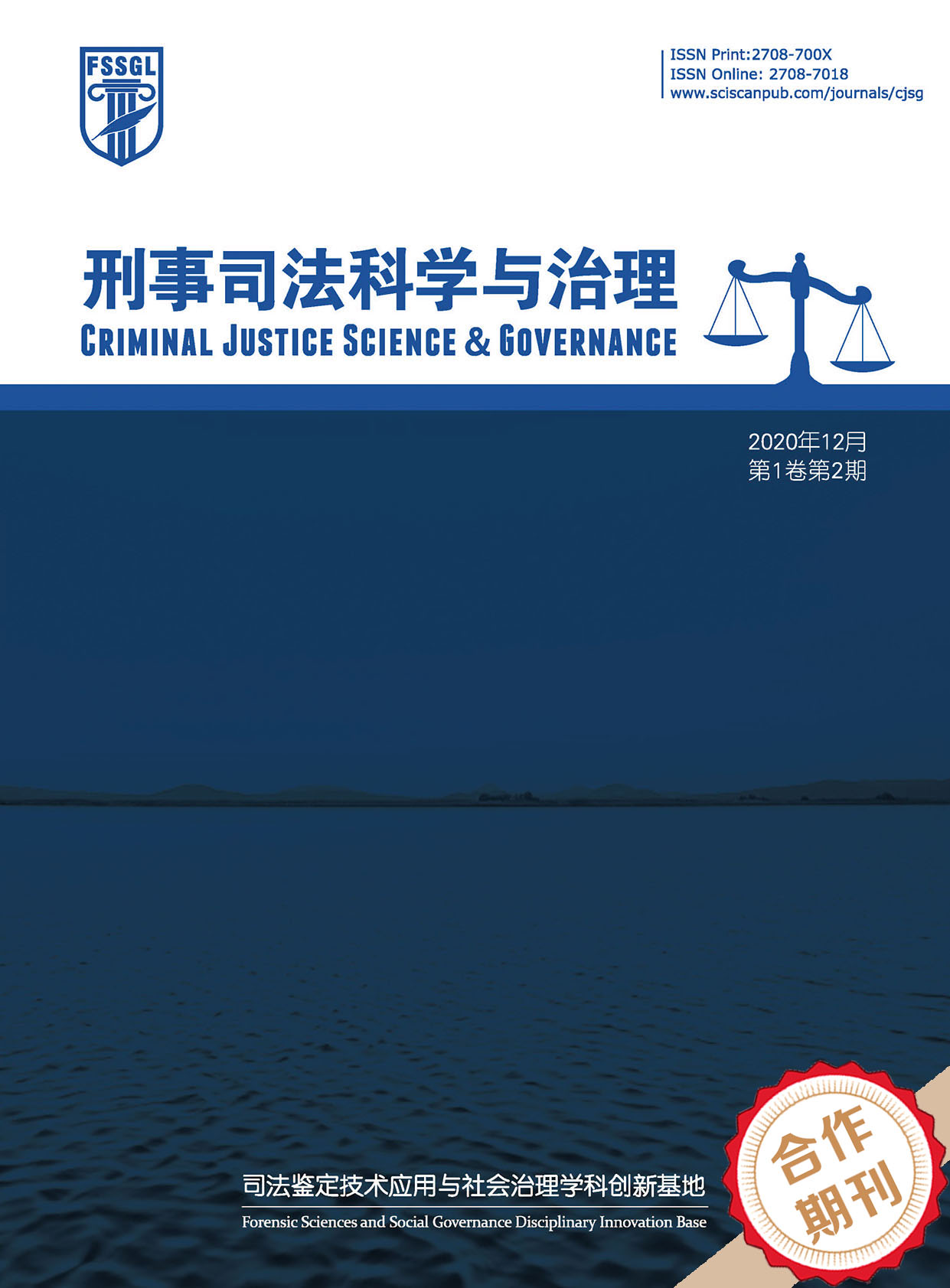Criminal Justice Science & Governance
电容式手触屏电子签名笔迹特征研究
Research on the Handwriting Characteristics of Capacitive Hand Touch Screen Electronic Signatures
- Authors: 王煊赫
-
Information:
华东政法大学,上海
-
Keywords:
Electronic signature handwriting; Changes in writing conditions; Handwriting characteristics电子签名笔迹; 书写条件改变; 笔迹特征
- Abstract: The purpose of this study is to explore the changes of signature handwriting characteristics of electronic writing instruments and writing carriers under different writing conditions, and to explore the relationship between the characteristics of electronic handwriting and paper handwriting, so as to provide a scientific basis for the identification of signature handwriting. Using a capacitive touch screen and stylus, the electronic signature handwriting of 30 volunteers was used as the research object, and 6 consecutive writing sessions were collected respectively. Slow, normal, and fast writing; Electronic signature handwriting for seated and standing writing. The handwriting characteristics of signatures on traditional paper carriers were compared with those of the traditional paper carriers, and the variation rules of handwriting features, layout features, and pen movement characteristics were analyzed. The results showed that the handwriting characteristics of electronic signatures will be affected by the proficiency of use, and the characteristics of electronic signatures written in unfamiliar situations are significantly different from those of paper signatures. When the writing speed changes, the changes of electronic signatures in terms of general characteristics and pen movement characteristics are similar to those of paper signatures, but they are different in layout characteristics. When the writing posture changes, the general characteristics and layout characteristics are similar to those of paper signatures, but the characteristics of pen movement are different. 本研究旨在探究电子书写工具和书写载体在不同书写条件下签名笔迹特征变化的规律,探寻电子笔迹与纸质笔迹特征之间的联系,为签名笔迹的鉴定提供科学依据。使用电容式手触屏和手写笔,以30名志愿者的电子签名笔迹为研究对象,分别采集6次连续书写,慢速、常速和快速书写,以及坐姿和站姿书写的电子签名笔迹,并与传统纸质载体上的签名笔迹特征进行比对,分析笔迹概貌特征、布局特征、运笔特征的变化规律。结果显示,电子签名笔迹特征受使用熟练程度的影响,在不熟悉的情况下所书写的电子签名与纸质签名特征变化差别明显;书写速度改变时,电子签名在概貌特征和运笔特征方面变化与纸质签名接近,但在布局特征上却体现不同;而书写姿势变化时,概貌特征和布局特征方面与纸质签名相近,但运笔特征又有所不同。
- DOI: https://doi.org/10.35534/cjsg.0601015
- Cite: 王煊赫.电容式手触屏电子签名笔迹特征研究[J].刑事司法科学与治理,2025,6(1):136-144.
一、前言
随着电子商务的快速发展以及各种电子书写设备的广泛应用,电子签名已经广泛应用于网络身份认证、交易签约、证据固定、责任溯源等场景。书写工具和书写载体与传统纸质签名完全不同,导致电子签名相较于纸质签名出现某些特征变异,这必然使传统的笔迹检验理论面临新的挑战。同样,由于男女生理性别的不同,其对相同事物的感知不同,对事物变化的适应能力也不同,当书写工具和书写载体发生改变时,其笔迹特征可能会出现不同程度的变化。
本文旨在探讨书写次数、书写速度和书写姿势等不同书写条件下电子签名笔迹变化的规律,考察不同性别书写者电子签名笔迹在概貌特征、布局特征和运笔特征这三方面的笔迹特征,同时对照纸质签名笔迹,探讨影响笔迹特征变化的原因,归纳总结电子签名笔迹特征变化的规律,从而为电子签名笔迹的鉴定提供参考依据。
二、实验部分
(一)实验器材
电容式手触屏(华为公司,HUAWEI MatePad 11,DBY-W09),其硬件尺寸为165.3×253.8×7.25mm,书写区域为140.5×215.7mm,及其配套电容书写笔(华为公司,HUAWEI M-Pencil(第二代)),系统自带书写软件;笔迹样本提取纸(得力A4纸)若干,其可书写区域为210×297mm;晨光大容量中性笔(K-35,0.5mm);文件检验仪(英国法斯特 VSC 6000);水平办公桌(高度750mm)及办公凳(高度430mm)。
(二)实验对象
甘肃政法大学本科生30人(男、女各15人)。将实验人员依次从1到30进行编号,男女分组分别采集样本。实验者年龄均在18到23岁之间,该年龄段书写人已基本形成书写习惯动力定型,书写技能进入稳定期,签名笔迹质量较高,且其适应能力、学习能力强,能够快速适应新设备。
(三)样本的采集
1. 实验前的准备
首先,为了减少环境等客观因素对实验者书写签名造成的影响,使其书写习惯和书写技能可正常、稳定地发挥,选择在安静、舒适、适宜书写的环境中采集样本。其次,为减少因实验者不熟悉电子设备的书写方式而带来的笔迹变形问题,在样本采集前对实验人员进行培训,使其熟悉并掌握后,再进行样本采集,并截屏保存。
2. 不同书写次数的电子签名笔迹样本采集
书写者采用舒适的书写姿势坐于水平办公桌前,可根据自己日常书写习惯调整电容式书写屏和样本提取纸在桌面上的位置。按照实验人员编号依次进行书写,书写者情绪保持正常,使其书写运动自然流畅,书写习惯反应良好。连续六次按照其正常书写速度书写自己的姓名,一次性完成,不可修饰重描或重新书写。
3. 不同书写速度下电子签名笔迹样本的采集
在坐姿状态下,书写者分别采用慢于其正常书写速度、常速和快于其正常速度三种书写速度,在书写屏和样本提取纸上书写姓名。
4. 不同书写姿势下电子签名笔迹样本的采集
书写者分别采用坐姿和站姿两种不同姿势,在固定高度的桌面上放置的电容书写屏和笔迹样本提取纸上书写签名。实验中可根据自身书写习惯适当对姿势进行调整以适应其视觉调整方式。书写者情绪保持正常,先在书写屏上采用坐姿连续六次按照正常速度书写自己的签名,然后在站姿条件下按照相同条件书写自己的姓名;按照相同的书写要求,在样本提取纸上书写姓名。
(四)纸质签名采集
按照与电子签名笔迹采集相同的条件,采集书写者在慢速、快速、常速、坐姿常速、站姿常速五种不同条件下的纸质签名笔迹,每种条件6份签名样本,共900份签名样本。对收集的纸质签名使用文件检验仪,以1200dpi分辨率对签名笔迹进行扫描保存。
三、结果与讨论
(一)书写次数对电子签名笔迹的影响
图1为不同性别书写者在电容式触摸屏上第一次、第三次和第六次书写的电子签名笔迹情况。由图1可以看出,尽管书写者已经掌握了使用电容笔书写签名笔迹的基本方法,但在实验正式开始时,由于书写工具的改变,书写者对新书写工具仍不太适应,书写速度减慢,书写水平下降,连笔特征和起收笔特征未能较好地体现。然而,随着书写次数的增加,书写者的表现逐渐改善,书写水平逐渐接近使用传统笔具时的水平,连笔特征和起收笔特征也更加明显和稳定。这表明,随着书写次数的增加,书写者对新型书写工具逐渐适应,能够更有效地将其个性化的签名笔迹特征转移到电子签名中。
考虑到现实签名情况,书写者在进行电子签名书写时,可能对其操作方法较为陌生。因此,为使实验数据对实务鉴定更有帮助,后续研究中选择了第一次书写的电子签名作为研究对象。

图 1 连续书写电子签名笔迹比对图(a女性,b男性)
根据表1的数据,可以看出在初次使用电子书写工具进行签名时,无论是男性还是女性书写者,均出现了书写水平下降的现象。具体来讲,女性签名笔迹中书写水平下降的样本为83份,约占女性样本的92.2%;男性签名笔迹中书写水平下降的样本为85份,约占男性总样本数的94.4%。
这一数据表明,不同性别书写者在初次尝试使用电子书写工具进行签名时,由于对新型书写工具不熟悉,无法像使用传统书写工具那样自然流畅地表达自己的书写特征,因此书写水平下降是一个普遍现象。
因此,在司法鉴定实践中,若检材是书写者在不熟悉电子书写工具操作方法的情况下书写而成的签名笔迹,并且只有正常纸质签名作为比对样本时,比对效果可能较差。进行电子签名笔迹鉴定时,鉴定人不仅要考虑到书写工具和介质变化对笔迹特征的影响,同时也要充分考虑到书写者初次使用电子书写工具时签名笔迹特征的明显变化,以避免鉴定结果误判。
表 1 书写次数对概貌特征影响
| 特征变化 | 女性 | 百分比(%) | 男性 | 百分比(%) |
| 书写水平下降 | 83 | 92.2% | 85 | 94.4% |
(二)书写速度对电子签名笔迹的影响
1. 对概貌特征的影响
强制慢写和快写都与书写者日常书写速度不同,违背其原有的书写行为习惯。因此,当要求书写者以不同于其往常书写速度进行签名时,他们可能会感到不适应,这种不适应会反映在其签名笔迹上,表现为书写水平的下降。
表2是书写速度对笔迹特征影响的统计数据。由表2可以看出,当书写速度发生变化时,女性书写者签名笔迹中出现书写水平下降的样本为72份,占女性总体样本的80%;男性书写者签名笔迹中出现该特征变化的样本为75份,约占男性样本总体的83.3%。数据表明,无论是男性还是女性,当书写速度被迫改变时,书写者原有的书写节奏和手部协调性受到影响,其签名的质量和特征也势必受到影响,因此书写水平下降是一个普遍现象。
表 2 书写速度对笔迹特征影响
| 特征种类 | 特征变化 | 女性 | 百分比(%) | 男性 | 百分比(%) |
| 概貌特征 | 书写水平下降 | 72 | 80% | 75 | 83.3% |
| 布局特征 | 字间距增大 | 38 | 42.2% | 40 | 44.4% |
| 倾斜程度增大 | 51 | 56.7% | 34 | 37.8% | |
| 运笔特征 | 连笔增多 | 75 | 83.3% | 83 | 92.2% |
| 笔画变异 | 47 | 52.2% | 51 | 56.7% | |
| 字形简化 | 15 | 16.7% | 18 | 20% |
2. 对布局特征的影响
如图2(a)中书写者“王煊赫”的签名笔迹,在慢速书写时表现出明显的特征变化。具体来讲,慢速书写时,笔画之间、结构之间的连贯性减弱,导致字与字之间的间距增大,签名整体上保持在同一水平线上。这也反映出书写者在慢速书写时更加注重每个字的独立性。但随着书写速度加快,字间距明显减小,且部分签名笔迹出现明显倾斜。这表明,随着书写速度的提升,书写者更加关注签名笔迹整体的流畅性。
相比之下,图2(b)中“李英德”的签名,随着书写速度加快,其字间距越来越小,但倾斜程度变化不明显。这说明不同书写者在书写速度这一条件发生变化时,其签名笔迹的变化模式存在差异。

图 2 书写速度不同对签名布局特征影响比对图(a、c女性;b、d男性)
通过对收集的笔迹样本进行分析观察,可以发现,书写者在书写速度发生改变时,上述签名布局特征的变化并非偶然,而是大多数书写者都会出现的特征。表2的数据也进一步证实了这一点。当书写速度发生变化时,女性签名笔迹中字间距增大的样本有38份,约占女性样本总数的42.2%;倾斜程度增大的样本有51份,约占女性签名的56.7%。男性签名笔迹中字间距增大的样本有40份,占男性总体的44.4%;倾斜程度增大的样本有34份,占男性总体的37.8%。
同时,还可观察到,同一书写者在不同载体上的签名在布局特征方面既有相同之处,又有不同之处。例如,书写者“王煊赫”在不同载体上书写时都存在随书写速度加快,字间距减小的特征,然而在倾斜程度变化上,其电子签名笔迹从慢速到快速有着较为明显的变化,而纸质签名的倾斜程度变化则不明显。又如“李英德”的签名字迹,其电子签名随书写速度的变化,字间距变化较为明显,而倾斜程度并未明显变化,一直趋于水平;但其纸质签名除字间距变化外,随着书写速度的加快,其签名整体向右下倾斜。
观察结果和数据都表明,书写速度对电子签名布局特征的影响并不完全适用于纸质签名。因此,在进行签名笔迹鉴定时,鉴定人员需要根据具体情况具体分析,考虑到书写速度对不同载体上签名特征的影响。
3. 对运笔特征的影响
(1)连笔特征
当慢速书写时,书写者按照实验要求,一笔一画缓慢书写其电子签名,这导致其连笔特征减小甚至消失。但是,由于注意力的局限性以及改变动作习惯难以长期持续,书写者往往不能长时间违背其熟悉的习惯进行书写。因此,在连续多次书写时,其签名笔画之间、结构之间虽彼此独立,但相互照应或存在意联,甚至会出现少量连笔特征。例如,图3(a)中“张爱梅”的签名笔迹,在慢速书写状态下“张”字也展现出少量的连笔特征。随着书写速度加快,前后相邻书写的笔画容易出现连写现象,或前一笔的收笔部位和后一笔的起笔部位反映出明显的意联。若强行快写,也可能会出现连笔混乱的情形,例如“梅”字。有时快速书写还会出现一笔成字现象,如图3(b)中书写者“刘伟”快速书写签名所示。结合表2的数据来看,女性签名中出现连笔增多的样本有75份,占女性总体的83.3%;男性签名出现连笔增多的样本有83份,占男性总体的92.2%。这表明当书写速度加快时,书写者出现连笔增多变化的现象较为普遍。
与书写者在不同书写速度下的纸质签名进行比对分析,可以发现,上述电子签名笔迹由于书写速度不同而对连笔特征造成的影响,在纸质签名中同样存在。由此可知,若书写速度发生改变,无论书写载体是电子屏幕还是传统纸质,书写速度的改变都会导致书写者的连笔特征发生相应的变化。而且,无论是在纸质签名还是电子签名中,连笔特征的变化趋势相似。

图 3 书写速度不同对签名连笔特征影响比对图(a、c女性,b、d男性)
(2)笔画变异特征
如图4所示,慢速书写时,笔迹的转折部分较为尖锐,这是因为书写速度降低,书写者有更多的时间和注意力来控制每一笔的细节。但随着书写速度加快,书写者对其签名笔迹各个笔画的注意力降低,更加注重签名笔迹整体的流畅性,导致其书写的签名字迹笔画转折部位更加圆润。
根据表2数据,可以看出,女性签名出现笔画变异的样本有47份,占女性样本总体的52.2%;男性签名出现笔画变异的样本有51份,占男性总体的56.7%。这些数据表明,该特征出现变化并非偶然,而是随着书写速度发生变化,大部分书写者都会出现的改变。同时,这种特征的变化不仅体现在电子签名中,在纸质签名中也有体现。

图 4 书写速度不同对签名笔画转折影响比对图(a、c女性,b、d男性)
(三)书写姿势对电子签名笔迹的影响
1. 概貌特征
概貌特征是指总观笔迹的全貌所体现出来的特点。在司法鉴定领域,观察分析概貌特征对辨别和对比签名笔迹具有重要作用。书写姿势对概貌特征的影响,主要体现在两个方面:书写水平特征和字的大小特征。
(1)书写水平特征
当书写者按照实验要求采用站姿进行书写时,由于这种姿势与书写者较为习惯的书写姿势不同,身体重心与视觉调整发生变化,对书写运动造成阻碍,书写者难以像在正常条件下那样自然地完成书写动作。这种书写条件的变化,反映在签名笔迹上,最直观的表现是书写水平下降,如图5所示。

图 5 书写姿势不同对签名书写水平影响比对图(a、c女性,b、d男性)
由表3可知,当书写姿势由坐姿变为站姿时,女性签名书写水平下降的样本有65份,约占女性总体的72.2%;男性书写水平下降的样本有68份,约占男性总体的75.6%。因此,不同性别书写者使用电子书写工具书写签名时,改变书写姿势出现该特征变化较为普遍。此外,通过观察同一书写者的纸质签名,发现当书写姿势发生变化时,同样会出现书写水平下降的现象。这说明,书写姿势的改变对书写水平的影响是普遍存在的,不论书写载体是传统纸质还是电容式手触屏。
表 3 书写姿势对笔迹特征影响
| 特征种类 | 特征变化 | 女性 | 百分比(%) | 男性 | 百分比(%) |
| 概貌特征 | 书写水平下降 | 65 | 72.2% | 68 | 75.6% |
| 字体变大 | 48 | 53.3% | 61 | 67.8% | |
| 布局特征 | 字间距增大 | 24 | 26.7% | 47 | 52.2% |
| 倾斜程度增大 | 51 | 56.7% | 34 | 37.8% | |
| 运笔特征 | 连笔增多 | 75 | 83.3% | 83 | 92.2% |
| 收笔拖拉 | 40 | 44.4% | 46 | 51.1% |
(2)字的大小特征
在研究书写姿势对签名笔迹字的大小特征的影响时,截取了书写者在不同姿势下的签名笔迹图像,并确保所有图像均在原图状态下,图片放大倍数统一为1。通过使用测量工具测量其签名笔迹的长和宽,可以更为直观地观察到签名笔迹的大小变化。
如图6(a)所示,“杨茜”坐姿签名尺寸为2.06×3.70cm,站姿签名尺寸为2.80× 5.95cm;如图6(b)所示,“陈亮君”坐姿签名尺寸为1.83×4.07cm,站姿签名尺寸为3.88×8.00cm;如图6(c)所示,“杨茜”坐姿签名尺寸为1.93×2.91cm,站姿签名尺寸为3.50×5.31cm;如图6(d)所示,“陈亮君”坐姿签名尺寸为1.77×3.86cm,站姿签名尺寸为4.29×7.00cm。
进一步观察分析表3,发现随着书写姿势的改变,女性书写者签名字迹出现字体变大现象的样本有48份,约占女性总体的53.3%;男性书写者出现该特征变化的样本有61份,约占男性总体的67.8%。这表明,当书写姿势发生改变时,书写者字体大小出现变化是较为普遍的特征。究其原因,站姿书写时,手臂需平伸,手腕和手肘部呈悬空状态,不能碰到书写屏,书写者的支撑点发生变化,对笔的控制难以做到像坐姿书写时那样精细,因而出现字体变大的现象。
通过观察纸质签名和电子签名在书写姿势发生改变时字体大小的变化,发现当书写条件改变时,不同性别书写者书写的签名笔迹均出现字体变大的现象。

图 6 书写姿势不同对签名字体大小影响比对图(a、c女性,b、d男性)
2. 布局特征
在书写姿势发生改变时,书写者会出现字体变大的现象。因此,对签名的字间距进行测量时,采用相对大小作为参考。如图7所示,书写者“殷琳雁”的电子签名和纸质签名在书写姿势改变时,其倾斜程度均增大,且整体向右上方倾斜。通过观察所收集的样本,发现当书写姿势改变时,签名笔迹向右上方倾斜是一种普遍特征。
然而,如图7所示,“张荣”的签名虽然随着书写姿势的改变其字间距增大,但其签名整体向右下方倾斜,且倾斜程度减小。这种变化虽与普遍特征不同,但其电子签名和纸质签名所表现的特征仍保持一致。因此可知,当书写姿势发生改变时,书写者的字间距和倾斜程度的变化在这两种书写载体上的表现是相同的。
与坐姿书写不同,站姿书写是从高位向低位悬腕书写,这种姿势违背了书写者的日常书写习惯,导致书写者对笔的控制能力减弱。因此,在站姿书写时,容易出现签名字迹整体倾斜程度增加、字间距变大的情形。
通过表3可以观察到,在书写姿势发生改变时,女性书写者出现字间距增大的样本有24份,占女性样本总体的26.7%;倾斜程度增加的样本有51份,占女性样本总体的56.7%。男性书写者出现字间距增大的样本有47份,占男性样本总体的52.2%;倾斜程度增加的样本有34份,占男性样本总体的37.8%。数据表明,当书写姿势发生改变时,不同性别书写者签名字迹的布局特征产生相应变化的现象较为普遍。

图 7 书写姿势不同对电子签名布局特征影响比对图(a、c女性,b、d男性)
3. 运笔特征
如图8(a)所示,“金子萱”的签名在站姿条件下,“金”字仅由两笔构成:第一笔为“丿”,剩余笔画一笔写成;“萱”字为上下结构,书写时“艹”与下半部分“宀”连笔,其余部分一笔写成。与坐姿条件下的签名相比,连笔特征明显增多。图8(b)中,“李凯盛”的电子签名在站姿书写时也呈现出特有的变化:“李”字的上半部分“木”两笔形成,“胜”字左右部分相连,且最后收笔时出现明显拖拉现象。

图 8 书写姿势不同对签名运笔特征影响比对图(a、c女性,b、d男性)
站姿书写时,由于控笔难度增加,书写者容易出现连笔增多甚至连笔紊乱的现象;运笔过程中可能出现明显的笔画抖动;收笔时拖拉,不易收笔。上述特征出现频率较高。观察表3可知,当书写姿势发生改变时,女性书写者出现连笔增多的样本有75份,占女性样本的83.3%;收笔拖拉的样本有40份,出现率为44.4%。男性书写者连笔增多的样本有83份,占男性样本的92.2%;收笔拖拉的样本有46份,出现率为51.1%。
观察书写者在相同书写姿势下形成的电子签名和纸质签名,发现书写者“金子萱”在纸质签名中出现的运笔特征变化与电子签名相近,都表现出明显的连笔增多现象。这表明在改变书写姿势的情况下,书写者的签名特征在不同书写载体上表现出一定的相似性。然而,对于书写者“李凯盛”的签名笔迹而言,其在纸质条件下不同姿势书写时,连笔特征的变化并不明显。这说明在书写姿势发生改变时,书写者的连笔特征在纸质签名和电子签名上可能表现出不同的特点。因此,在进行电子签名笔迹鉴定时,不可直接使用纸质签名作为比对样本。
四、总结
本文收集了30名志愿者因书写次数、书写速度、书写姿势等书写条件变化所产生的电子签名笔迹,并与传统纸质载体上的签名笔迹从概貌特征、布局特征和运笔特征三方面进行了观察、对比和分析。
研究发现,当书写者对电子书写工具不熟悉时,不同性别书写者的签名所表现出的原有笔迹特征都较差。但随着书写次数的增加,书写水平均有所提高,书写者的笔迹特征得到更好的展现,与正常纸质签名更加接近,此时两种签名的笔迹特征存在一定的关联性。
当书写速度发生改变时,不同性别书写者的电子签名在概貌特征和运笔特征方面的变化与纸质签名较为接近。但从布局特征方面观察,纸质签名并不一定出现相同的变化,且不同性别在布局特征变化方面差异较大:女性书写者的电子签名出现字间距增大的概率小于男性,而倾斜程度发生变化的概率又远大于男性。
当书写姿势发生改变时,不同性别书写者的签名笔迹在概貌特征和布局特征方面的变化在两种书写载体上较为接近,但在运笔特征方面,书写者的连笔特征在纸质签名和电子签名上表现出不同特点,这与书写速度发生改变时的情况
相近。
因此,当检材为电子签名且无相同条件下的比对样本,只有传统纸质签名为样本时,比对效果较差,难以得出较为准确的鉴定意见。在进行签名笔迹鉴定时,鉴定人员必须考虑到书写条件变化对签名特征可能产生的影响,并尽可能收集相同书写条件下的签名样本。这也有助于更准确地分析和比对签名特征,从而提高签名笔迹鉴定的准确性和可靠性。同时,对于可能受到书写条件影响的签名,鉴定人员应该谨慎地评估其可靠性,并充分考虑条件变化可能带来的影响。
















